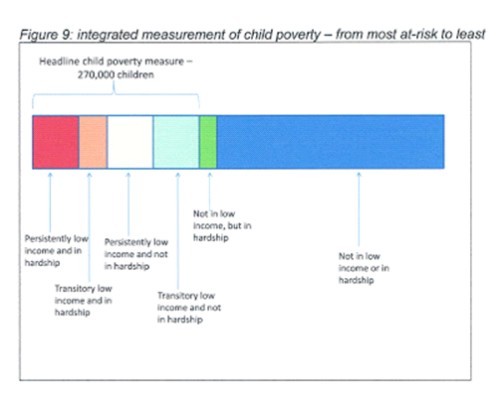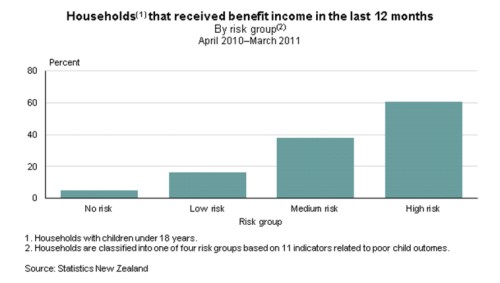Something about the way the Left is presenting the ‘child poverty’ problem doesn’t stack up. When interviewed, Green co-Leader Metiria Turei repeatedly stresses that 2 in 5 of officially poor children come from working homes. Their parents are doing their best to provide for their children but not making ends meet. It’s unacceptable, she says.
They probably are doing their best and deserve respect for their work effort. Some wages are low and some rents are high. Certainly that presents a problem for those parents. But for Turei and other anti-poverty advocates to continually highlight this group when attempting to influence voters implies there is something less laudable about being benefit-dependent. Not a sentiment normally associated with the Left.
So what’s going on?
The majority of poor children[i] rely on benefit income. Most begin there at birth or shortly after, and around half remain there for 7 or more years.[ii] The following table[iii] compares the number of beneficiaries who had one or more children born into their care to total births in the same year:
Number of main benefit recipients at the end of each calendar year aged 16-64 years with one or more dependent child born into their care that year
|
Dec 05 |
Dec 06 |
Dec 07 |
Dec 08 |
Dec 09 |
Dec 10 |
Dec 11 |
Dec 12 |
|
12,391 |
11,960 |
12,235 |
13,421 |
14,394 |
14,537 |
13,364 |
12,952 |
|
57,745 |
59,193 |
64,044 |
64,343 |
62,543 |
63,897 |
61,403 |
61,178 |
|
21.50% |
20.20% |
19.10% |
20.80% |
23% |
22.80% |
21.80% |
21.20% |
Immediately obvious is the reasonably consistent pattern through periods of low and high unemployment. This indicates a degree of foreknowledge on the part of the parent that their child would have to rely on welfare. The situation did not come as a surprise. For most it was not the result of an unexpected workplace redundancy. Put baldly, a choice was made to commit their child to a period, possibly prolonged, of exposure to poverty.
For Maori the data shows significantly higher percentages:
Number of Maori main benefit recipients at the end of each calendar year aged 16-64 years with one or more dependent child born into their care that year
|
Dec 05 |
Dec 06 |
Dec 07 |
Dec 08 |
Dec 09 |
Dec 10 |
Dec 11 |
Dec 12 |
|
5,801 |
5,656 |
5,840 |
6,261 |
6,677 |
6,782 |
6,488 |
6,261 |
|
16,437 |
17,342 |
18,717 |
18,844 |
18,027 |
18,458 |
17,608 |
17,439 |
|
35.30% |
32.60% |
31.20% |
32.80% |
37% |
36.70% |
36.80% |
35.90% |
Again, it’s important to note it’s not the unemployment benefit supporting most of these children. In 2013 only 6 percent had a parent(caregiver) on the unemployment benefit. 77 percent had a parent on the DPB.[iv]
This pattern stretches back a generation to at least 1993. According MSD research:
An estimated one in five children born in 1993 spent seven or more of their first 14 years of life included in a benefit, and one in ten spent 11 or more of those years included in a benefit.[v]
Now, not all children in poverty experience deprivation. For instance, if their parent experiences a short period of unemployment or loss of work hours, there may be savings to fall back on.
When Treasury looked at those at-risk it found more than half of the officially poor children were not experiencing hardship.[vi] The largest group experiencing hardship (red) also had persistently low incomes. This suggests they are children in beneficiary homes.
But let’s not simply assume.
The following table shows that of those parents with a high risk of hardship (characterised by the presence of five or more factors including being a victim of crime; discrimination; feeling isolated; being a smoker; having poor physical health, a housing problem or overcrowding; living in a high deprivation area or having limited access to facilities), 60 percent had received benefit income in the past 12 months.
Furthermore Statistics NZ observes:
“Sole parents are more likely to have low income compared with two-parent families. This is one reason sole parents are more at risk. However, family structure also plays a role. For households in the bottom two income quintiles, 58 percent of high-risk and just 25 percent of no-risk households are sole-parent households. This compares with two-parent-only households where the relationship is reversed, with 69 percent no-risk and 34 percent high-risk households.”[vii]
The heightened risks are associated with sole parent, long-term welfare dependence. The risks for two-parent households, where employment is higher, are considerably lower.
Yet (I return to my opening) it is the plight of the working poor the Left continues to highlight. It’s a direct and powerful appeal to that strong Kiwi sense of justice. We want to believe that parent’s work efforts are fairly rewarded, and their children get the same opportunities as children from higher income homes.
The good news is that the working poor do not generally stay poor. As children grow, the opportunity for a second earner to supplement household income moves people out of poverty. Yes, some poor households already feature two earners. But they also contain higher than average numbers of children who accrue substantial family tax credits – a policy the current government retained. It is difficult to imagine what else a government can do for low-income working families already effectively paying no tax, beyond indirect measures to lift productivity and wages, and lower rents (especially in Auckland).[viii] It has always been the case that most people will be poorer when they are starting out with young families. Upward mobility is what really matters.
Broadly speaking, children in poor working homes tend to experience temporary poverty; children in beneficiary home experience chronic poverty. It’s the second experience that harms.
Therefore, the alleviation of child poverty should be sharply focussed on welfare dependence.
In April last year the Prime Minister’s Six monthly report of the Ministerial Committee on Poverty drew a similar conclusion:
“The issues of low income and material hardship in New Zealand are primarily concentrated within a small group of households that are persistently on benefit, on low incomes and in hardship, rather than being broad based across households….A key dimension of material hardship in New Zealand is that some groups have higher concentrations than others. In particular, the groups with the highest rate of poor material and social outcomes are those on the Domestic Purposes, Sickness and Invalid benefits, those born to mothers who had children before they were 20, and those with incomes in the lowest quintiles. Maori and large families also have a higher risk.”
In consequence, the Left’s best idea is to simply put more money into the identified households. Superficially well-intentioned, this move also conveniently appeals to the very voters Matt McCarten wants to mobilise. But increasing benefits is not popular with all in their constituency (hence the constant marshalling of the working poor as opposed to the welfare poor). To make the Best Start policy electorally palatable, Labour clumsily tried to make it look like they were all but universalising the extra income. Make no mistake though. David Cunliffe’s ‘baby bribe’ has the greatest marginal value to an existing or prospective sole parent beneficiary, not a low-income working family. For example, in the first 26 weeks a new mother who has been working would only receive paid parental leave – the equivalent or less than previous income. The non-employed mother already on a benefit or taking one up at her child’s birth, receives additional income.
Similarly, the Green’s policy to pay the In Work Tax Credit to beneficiary families will also make welfare pay more. Michael Tanner, in The End of Welfare, identified eight studies showing that higher welfare payments increased the rate of unmarried births.[ix]
Thankfully the Ministerial Committee recognises this recalling that the Welfare Working Group noted, “… incentives in the benefit system should not encourage fertility and partnering decisions that are not in the best interests of the mother and her children.”
It is work, not welfare, that’s critical to lifting incomes. The last Labour government understood this. The prospective coalition clearly does not.
Fortunately advisers to the current government also ‘get it’. The last word goes to the Prime Minister’s poverty committee:
Ultimately it is home and educational environments that matter more than income by itself. Therefore there may be a rationale for further linking income support to particular parental actions (ECE, immunisation etc); increasing case management / regular review and working toward expectation of going off benefit after a defined period; providing low-cost or free services and ensuring work incentives, including for part-time work.
[i] In 2011 around 53 percent of children living in households that fall below 60% of the median after housing costs equivalised income were in a benefit-dependent home, with a further 12 percent relying on one part-time worker who may also receive benefit income.
[iii] Compiled from data supplied under the OIA
[vii] Vulnerable children and families: Some findings from the New Zealand General Social Survey, 2010, http://www.stats.govt.nz/browse_for_stats/people_and_communities/Children/vulnerable-children.aspx
[viii] An expert group is currently examining the accommodation supplement and why those in hardship tend to be in rental accommodation
[ix] Michael Tanner, End of Welfare, Cato Institute 1996, p78-80



